The World Meteorological Organization (WMO) has published a report predicting that even if the world achieves its goal of limiting the temperature rise to 1.5 ℃ higher than pre‐industrial levels "Sea levels will continue to rise for the next 2,000 years, with a maximum rise of 3 m." The maximum rise will be about 6 m, even if temperatures increase by less than 2 ℃, the goal of the Paris Agreement, the international framework to limit climate change. This report is a shocking reminder that a large sea level rise is inevitable and will affect humanity. The UN's Intergovernmental Panel on Climate Change (IPCC) has predicted a worst‐case scenario of a more than 1 m increase in the sea level by the end of the century.
Even a 1 m sea level rise would pose an existential threat to low‐lying island nations known as Small Island States. As a result of this change, Japan is expected to lose more than 90% of its sandy beaches. Every country worldwide is taking steps to reduce greenhouse gas emissions such as carbon dioxide (CO2), but it will not be easy to achieve the 1.5 ℃ target.
As a result of these challenges, "adaptation" measures to minimize the effects of climate change have become extremely important in addition to greenhouse gas reduction measures. In response to the WMO report, UN Secretary‐General Guterres expressed a sense of urgency at a meeting of the Security Council, saying, "The danger is especially acute for some 900 million people living in coastal zones at low elevations."
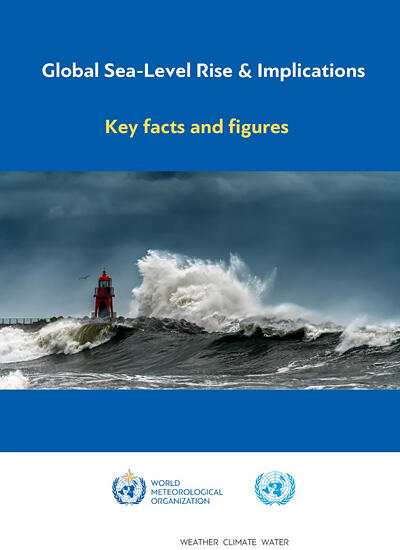
(courtesy of WMO)
A yearly acceleration in the rate of increase due to melting ice sheets and glaciers
Although large sea level rises have occurred many times in the long history of Earth, it is thought that there have been no large changes in the last few thousand years. However, the IPCC has repeatedly pointed out and warned that the rate of rise is increasing because of expanding oceans and melting Arctic and Antarctic ice sheets as the Earth warms.
The WMO's latest report, "Global Sea Level Rise and Implications," states that since 1900, global sea levels have risen faster than in at least the previous 3,000 years, rising 0.2 m between 1901 and 2018, according to coastal tide gauges and satellite observations.
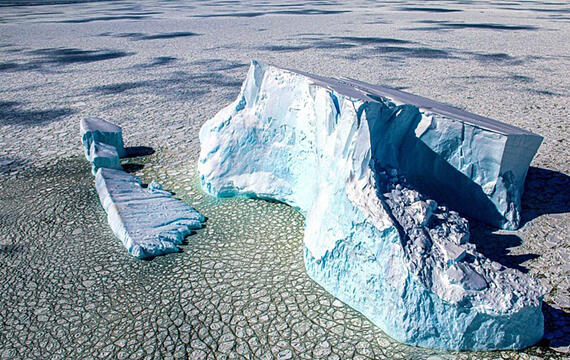
(Photo: Gonzalo Bertolotto, courtesy of WMO)
The data also showed that the rate of increase averaged 1.3 mm/year from 1901 to 1971 to 1.9 mm/year from 1971 to 2006, and then accelerated each year to 4.5 mm/year from 2013 to 2022. The WMO stated, "It is highly likely that anthropogenic influences have been the dominant cause of sea level rises since at least 1971".
The WMO further noted that half of the factors contributing to sea level rises from 1971 to 2018 were thermal expansion of seawater because of global warming, whereas melting of ice sheets and glaciers was the main factor from 2006 to 2018. Citing a study by the National Aeronautics and Space Administration, the WMO stated that there is a high risk that sea levels will continue to rise in the future because of melting of the Antarctic ice sheet.
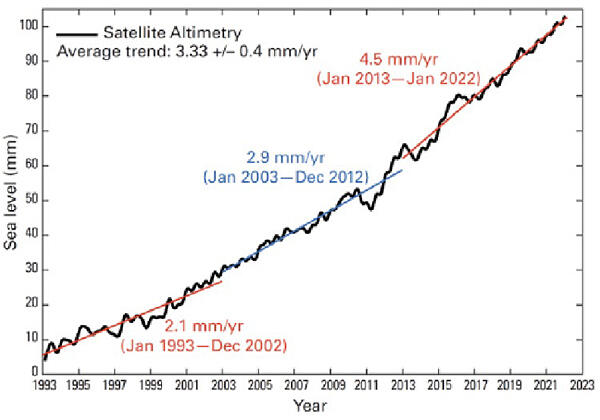
(courtesy of WMO)
5 ℃ rise projected to be up to 22 m.
The Working Group I report released by the IPCC in August 2021 projected that even under a scenario that limits the temperature rise to "less than 2 ℃" by 2100 (SSP1‐2.6 scenario), the sea level will rise 0.32‐0.62 m above the average sea level between 1995 and 2014 by 2081‐2100. In addition, under the worst‐case scenario (SSP5‐8.5 scenario), in which countries do not take action to reduce greenhouse gas emissions without transitioning away from a dependence on fossil fuels, sea levels are projected to rise by 0.63‐1.01 m by 2100. Thus, given the current lack of progress by individual countries, the average global sea level may rise by more than 1 m by the end of this century.
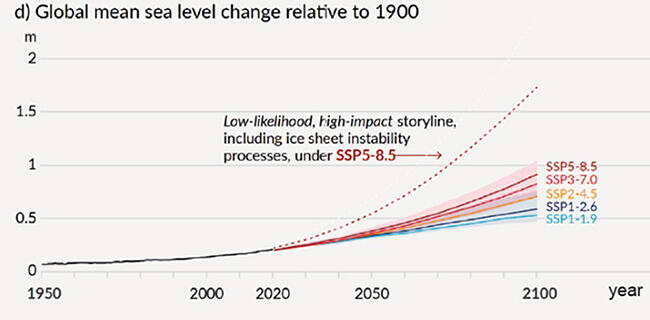
(courtesy of IPCC)
The Paris Agreement was adopted at the 2015 Conference of the Parties (COP21) to the United Nations Framework Convention on Climate Change and entered into force in 2016. The agreement sets a goal of limiting the increase in global temperatures to "less than 2 ℃" above pre‐industrial levels by the end of the century, and preferably to "1.5 ℃". It also requires that all countries, including developing countries, set voluntary targets and take action to reduce greenhouse gas emissions.
However, the global average temperature has already risen by more than 1 ℃. In response to the growing sense of urgency, at COP26 in the fall of 2021, countries agreed to make efforts to limit the temperature increase to 1.5 ℃. "1.5 ℃" has become the de facto goal for the international community.
The WMO report predicts that even if the temperature rise is limited to 1.5 ℃, the sea level rise over the next 2,000 years will be approximately 2‐3 m, and 2‐6 m, even at 2 ℃. If the temperature rises to 5 ℃, the sea level rise is expected to reach approximately 19‐22 m. Projections for the sea level rise for the Earth's future in the next century and beyond are shocking data that have not been included in any previous IPCC report.
Estimates of US$14.2 trillion in lost assets due to inundation damage
The WMO report also presented a wide range of data to predict the severe impacts of continued sea level rises. The report emphasizes that the sea level rise will continue beyond 2100 and will have a serious impact on the survival of small island states, as well as on coastal ecosystems, people, and infrastructure. The small island states include Tuvalu in the South Pacific and the Maldives in the Indian Ocean. The UN list of Small Island Developing States includes 38 UN member states and non‐member states in the Pacific, Caribbean and African coastal regions.
The study also projected that a sea level rise of 0.15 m would result in flooding on a "once in a century" scale, with the number of people affected increasing by around 20% from 2020, doubling in 2020 with a rise of 0.75 m, and tripling with a rise of 1.4 m. The report estimates that a failure to reduce greenhouse gas emissions would result in between $8.8 trillion and $14.2 trillion in lost assets in flood‐affected areas.
Developing countries made their presence felt at COP27 in Egypt last November, particularly small island states that are most vulnerable to sea level rises.
The main theme of COP27 was "loss and damage" to developing countries caused by climate change. After a difficult process, the conference agreed to establish a "loss and damage" fund. The fund dates back to a time when small island states, with a strong sense of urgency that their countries were under threat, were seeking a system to compensate for climate change damages caused by greenhouse gases that had been emitted mainly by industrialized countries for approximately 30 years.
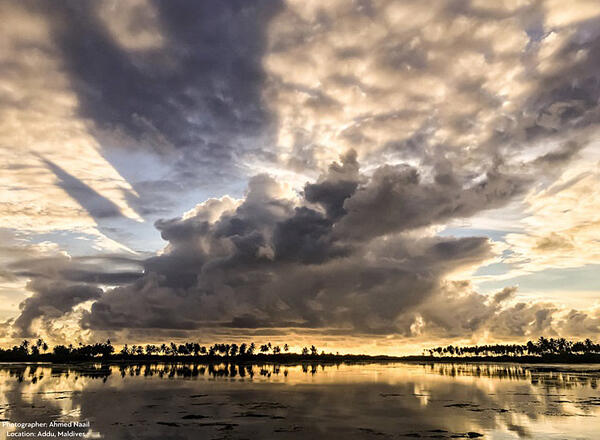
(Photo by: Ahmed Naiil, courtesy of WMO)
"One in ten people on Earth at risk," states the Secretary‐General
Following release of the WMO report, UN Secretary‐General Guterres emphasized the need to respond through international law and the international human rights framework at the February 14 Security Council meeting on the global impacts of sea‐level rise.
In this context, Guterres began by saying: "Global average sea levels have risen faster since 1900 than over any preceding century in the last 3,000 years. Countries like Bangladesh, China, India and the Netherlands are all at risk. The danger is especially acute for nearly 900 million people who live in coastal zones at low elevations — that is one out of ten people on earth," he said.
He added: "Our world is hurtling past the 1.5 ℃ warming limit that a livable future requires, and with present policies, is careening towards 2.8 ℃ by the end of this century." He called for urgent action to reduce greenhouse gas emissions and financial support for developing countries, such as small island states, which will be severely affected by rising sea levels.
Guterres explained that Antarctica and Greenland are losing an average of 150 billion and 270 billion tons of ice mass per year, respectively.

(Photo: Loey Felipe, courtesy of the UN)
(UCHIJO Yoshitaka: Science Journalist)
Original article was provided by the Science Portal and has been translated by Science Japan.




